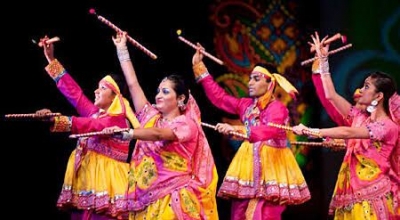
Garba is a form of dance which originated in the state of Gujarat in India. The name is derived from the Sanskrit term Garbha (“womb”) and Deep (“a small earthenware lamp”). Many traditional garbas are performed around centrally lit lamp or a picture or statue of the Goddess Shakti. Traditionally, it is performed during the nine-day Hindu festival Navaratri. Either the lamp (the Garba Deep) or an image of the Goddess, Durga (also called Amba) is placed in middle of concentric rings as an object of veneration.
Garba is performed in a circle as a symbol of the Hindu view of time. The rings of dancers revolve in cycles, as time in Hinduism is cyclical. As the cycle of time revolves, from birth, to life, to death and again to rebirth, the only thing that is constant is the Goddess, that one unmoving symbol in the midst of all of this unending and infinite movement. The dance symbolizes that God, represented in feminine form in this case, is the only thing that remains unchanging in a constantly changing universe (jagat).
Both men and women usually wear colorful costumes while performing garba and dandiya. The girls and the women wear Chaniya choli, a three-piece dress with a choli, which is an embroidered and colorful blouse, teamed with chaniya, which is the flared, skirt-like bottom, with intricate work and dupatta, which is usually worn in the traditional Gujarati manner. Chaniya Cholis are decorated with beads, shells, mirrors, stars, and embroidery work, mati, etc. Traditionally, women adorn themselves with jhumkas (large earrings), necklaces, bindi, bajubandh, chudas and kangans, kamarbandh, payal, and mojiris. Boys and men wear kafni pyjamas with a Ghagra – a short round kurta – above the knees and pagadi on the head with bandhini dupatta, kada, and mojiris. In Gujarati, this costume worn by men is called ‘Kediyu’. Over the years, the interest in Garba has only increased. There is a huge interest in Garba among the youth of India and in particular, the Gujarati diaspora. Traditionally, this dance is performed in concentric circles and the entire group performs once step in sync, with the beat starting slow and slowly catching on speed. It is a sight to behold.
Picture Credit : Google
